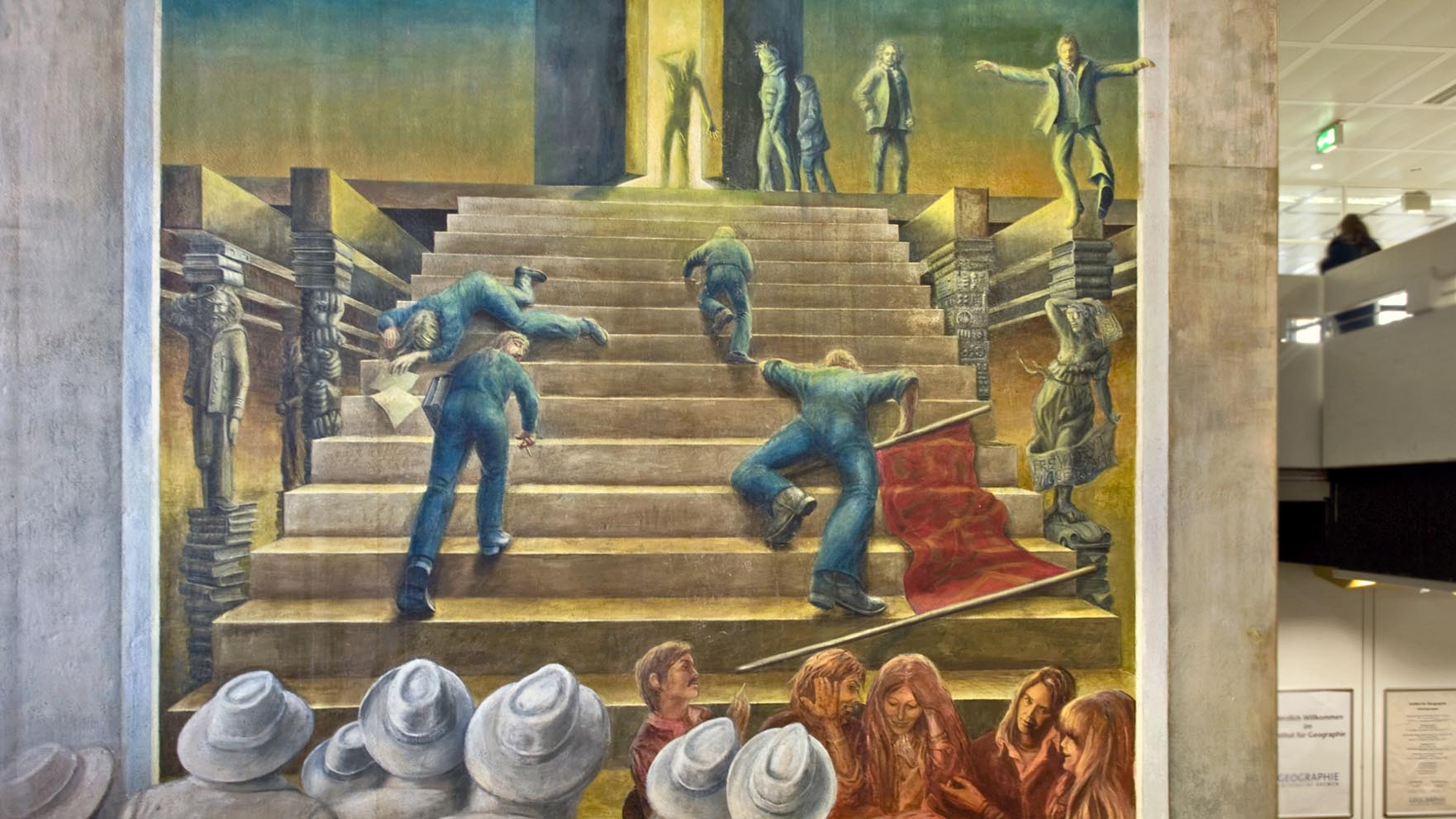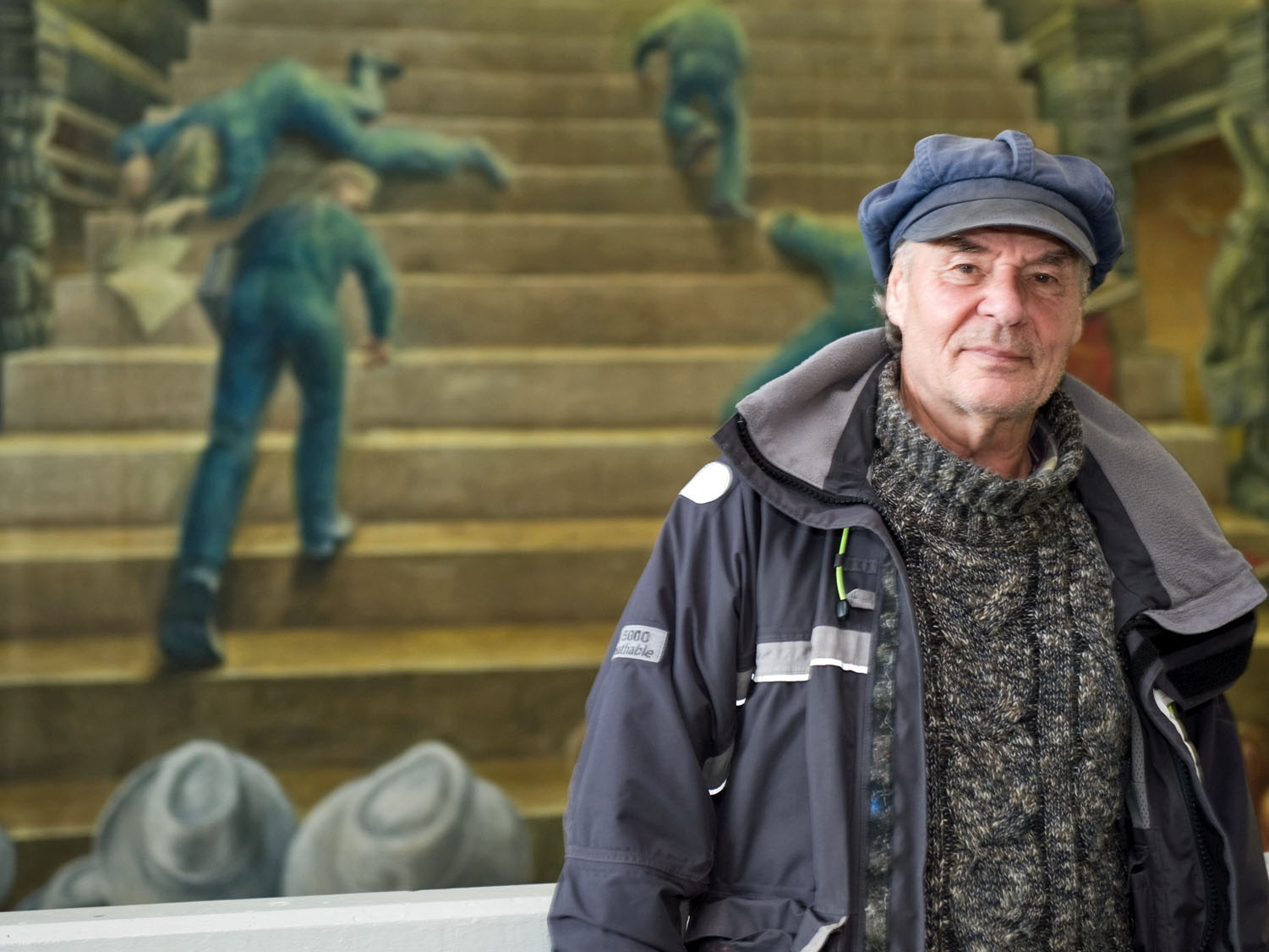
Harald Rehling
Have You Heard of… the Wall Painting in the GW2 Foyer?
There is a great deal to be discovered on campus but what is the story behind it all? up2date. has collected the answers for all of you curious readers. Welcome to your tour of the campus!
“We were rather prophetic, weren’t we?” muses Jimmi D. Paesler as for the first time in many years he once more stands in front of the wall painting on the ground floor of the GW2 building. He hasn’t seen it for such a long time and is surprised about the good condition of the acrylic painting.
“We were rather prophetic, weren’t we?” muses Jimmi D. Paesler as for the first time in many years he once more stands in front of the wall painting on the ground floor of the GW2 building. He hasn’t seen it for such a long time and is surprised about the good condition of the acrylic painting. The Bremen artist was an adjunct lecturer in the field of art education at the University of Bremen until well into the nineties. He spent four semesters working with a group of students on the concept for the painting that was eventually finished in 1981. The theme: “Art in public spaces”. The six by ten meter wall painting depicts the situation of university studies from the perspective of students. A closer examination reveals its allegorical character and time-related hidden symbols.
The Beginning of Digitalization
Paesler, now in his mid-seventies, with his flat cap, earrings, and twinkle in his eye, is clearly still of defiant spirit. “We wanted to draw attention to the pending upheavals,” he explains. “The ‘marketization’ of studies, the uncertainty of future employment, the sense of insecurity among students. We saw it coming. The humanities were being downsized. That’s happening at an even faster rate today.” And it was a time when digitalization was just beginning to emerge. As a logical consequence, one of the pillars on the side of the central stairway of ascension in the picture is standing on a pedestal of computers. “Yes, they really were as big as that back then,” he laughs.

Uncertain Future
The former lecturer easily remembers the names of the people portrayed by the work group painted in red tones. The girl second from right is Ulrike. She had the idea of choosing a quote from the Bild newspaper. The gray men in hats with their backs to the observer featured in the fore of the picture were inspired by the famous painting by Richard Oelze called “The Expectation”. Oelze, who lived in Worpswede near Bremen, created the surrealistic motif in 1935. Now, together with the observer, the gray men in GW2 look through a plastic-type frame into the actual picture. On the stairway, they can see stumbling students who have given up the political struggle. This is symbolized by a discarded red banner that is sliding back down the steps. The uncertain future in societal reality is illustrated by a crack of light shining through a small opening between two heavy security doors.
Marx as an Invalid
“Did you notice the invalid Marx?” Paesler chuckles and points to the figure of Marx standing on the volumes of his collected works, the famous “blue books”. The balled fists holding up the next column are intended as a parody of the K-groups (Maoist and communist-leaning political groups in the student movement). The counterpart to Marx is portrayed on the right-hand side of the picture: A hermaphrodite with a face like Woody Allen, a banknote in one hand and a banderole bearing the words “Freiheit der Wissenschaft” (Academic Freedom) in the other – the student art group wanted to mock science for its phony righteousness. They were wild times. “The guy at the top on the right, who is about to jump from the wall because he can’t make the transition to a successful career – that’s Victor Ströver,” says Paesler. His former student now runs a web-design company from a villa in Schwachhausen, a prosperous suburb of Bremen. It seems that things worked out better than expected.
Explanation of Pictures during Guided Tours
“The second from left in the work group, that’s me. I had really long hair back then.” Jimmi Paesler is pleased to hear that the meaning of the wall painting is always included in guided campus tours. But he does have a special wish: “There should be a plaque next to the painting bearing the names of its creators”.
Further information on the Bremen muralist and former adjunct lecturer Jimmi D. Paesler.